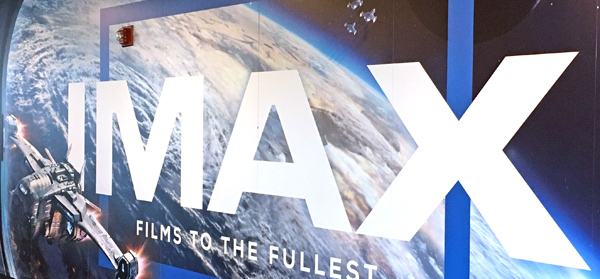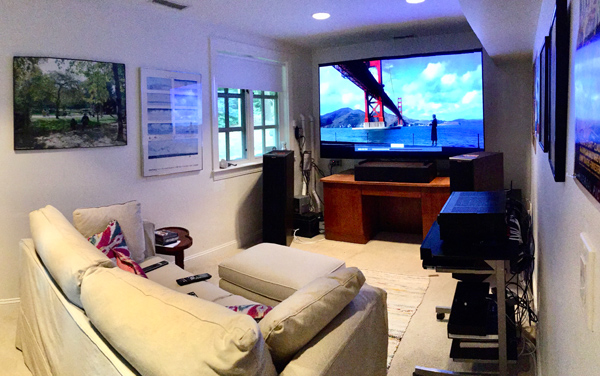Eighteen Years Later |
Read more at in70mm.com The 70mm Newsletter |
| Written by: Jonathan Kleefield, M.D., Boston, USA | Date: 11.08.2023 |
 Back
in 2005, our editor kindly published an article I wrote concerning my
reminiscences regarding state-of-the-art, 70mm movie theatres I had the
opportunity to attend, growing up in New York City, USA. They were very fond
memories, given my early interest in motion pictures and the desire to see
them with maximal image and sonic quality. Back
in 2005, our editor kindly published an article I wrote concerning my
reminiscences regarding state-of-the-art, 70mm movie theatres I had the
opportunity to attend, growing up in New York City, USA. They were very fond
memories, given my early interest in motion pictures and the desire to see
them with maximal image and sonic quality. • Go to A Nostalgic View of 70mm in New York City - 1950-1970 • Go to "Oppenheimer" Reviews • Go to Now showing in 70mm in a theatre near you! In the eighteen years that have transpired since that article, I have sporadically attended motion picture presentations in my home city, Boston, Massachusetts (US), and elsewhere throughout the country. As most readers of this newsletter know, the opportunities to view films in 70mm have become rare events, beginning with the high cost of using 70mm film and the few venues available to display it. Also, the subject matter deserving of such a format has become rather scarce, with occasional “blockbuster” films being photographed in 70mm or “blown up” from 35mm film. An exception to this paradigm is the extraordinary work of Ron Fricke, whose amazing films, “Chronos,” (IMAX) "Baraka" (Todd-AO) and "Samsara" (Panavision System 65) were photographed by him with a custom built 65mm camera of his own design. Added to it was an intervalometer he constructed, and which permitted time lapse photography, as well as coordinated, progressive movement of the camera during the time lapse sequence. The results are extraordinary, and those of you who have not experienced these films are urged to view them. The other, and now dominant factor encroaching upon the use of 70mm film as a recording medium is the emergence of digital cinema, pioneered by the visionary George Lucas around the time of the Millennium. Lucas collaborated with Sony to produce and then utilize the Cine Alta video camera. At first, I was skeptical that video could ever emulate the appearance of an image obtained with photographic film, given its tremendous dynamic range, resolving capacity, color saturation, and grain structure. However, I am far less dubious regarding this distinction at this time, given the emergence of remarkable digital cameras produced by Arri, Red, and Panavision. Currently, the Arri Alexa is the most frequently employed in the theatrical world. This camera is available in several versions, with the Arri Alexa 65 sporting an image sensor approximately the same size as a 65mm film. Even IMAX now has digital cameras in its lineup that approach, but do not quite meet the resolving capacity of its film format (15 perforation 70mm film run horizontally through the projector). |
More in 70mm reading: "Oppenheimer" Reviews A Nostalgic View of 70mm in New York City - 1950-1970 Chronological premiere list of all 70mm films Now showing in 70mm in a theatre near you! in70mm.com's Library Presented on the big screen in 7OMM Peripheral Vision, Scopes, Dimensions and Panoramas |
 "I
was shocked to view an image with very limited contrast, poor color
saturation and focus, and a deafening sound level forcing me to put my
fingers in my ears! I stuck out the entire two hours and twenty minutes of
the film, and left with a pounding headache." "I
was shocked to view an image with very limited contrast, poor color
saturation and focus, and a deafening sound level forcing me to put my
fingers in my ears! I stuck out the entire two hours and twenty minutes of
the film, and left with a pounding headache."Coincident with the transition from film to digital recording is the virtual cessation of film projection in movie theatres, with major conversion to digital cinema in the USA beginning in 2010. While the camera technology has advanced substantially, as noted above, it is my opinion that the “weakest link in the chain” is the digital cinema venue itself. I’ve been to several of these facilities in the last few years, and the results have been disappointing. Screen luminance has been suboptimal, image clarity in no way comparable to its film predecessor, and worst of all, sound levels set so high as to potentially damage hearing, or low enough as to make it almost impossible to discern dialog. I admit that this is not necessarily the fault of the equipment, but rather the individuals who should be adjusting and monitoring the operation of these devices. In that regard, the last presentation I screened was at an IMAX-equipped theatre in Boston, which was running the 2019 version of “West Side Story.” I attended this feature in December 2021. I, and only five other patrons, came into this 500 seat auditorium, and thus had no problem in locating the “ideal” seat, in terms of its relation to the screen. Sadly, this modern cinema has no curtain, and one is forced to stare at a blank wall until being barraged by 30 minutes of advertisements. When the actual presentation finally began, I was shocked to view an image with very limited contrast, poor color saturation and focus, and a deafening sound level forcing me to put my fingers in my ears! I stuck out the entire two hours and twenty minutes of the film, and left with a pounding headache. There was no operator in the projection booth, and consultation with the few theater staff on site resulted in my being told that the show is “automated,” precluding any adjustments in picture or sound. I followed up this ordeal with a long email regarding these issues, sent to the IMAX customer service department in Canada, and never even received an acknowledgment of receipt of the communication. I made this foray to the theatre as its director, Steven Spielberg, maintains that the best way to enjoy films is in a theatre- in this case, I would assume he would not endorse my experience as being representative of that contention. Having remained a film enthusiast, I decided to finally take matters further, and purchased an 83 inch Sony A90J OLED display, a Denon AVR 3700 receiver, a suite of Klipsch loudspeakers and subwoofer. This system is connected to either my Oppo 203 or Panasonic 820 4K Blu-Ray player. All cabling supports the data transfer rates necessary to take advantage of the high quality sound formats on some discs, and of course, to optimally display the 4K image, either native or up-converted. The results, confirmed by my viewing of the same Spielberg “West Side Story” film on a 4K disc have produced a far more satisfying experience- amazing image quality and fantastic sound. Simply put, there is no comparison between what can be achieved in a home environment to what may now be the current “standard” for theatrical digital cinema. While the investment to buy this equipment approached that of the most basic of used automobiles, I have already enjoyed viewing dozens of DVD’s, Blu-Rays and a few 4K discs, so the “payback,” in my opinion, has already been satisfied. We hope to have this system for years to come. |
|
 Author's
home theatre "I have found cinematic Nirvana in the form of my little
basement theatre. While it may not seem a big advantage, also having the
ability to pause a lengthy picture in order to fulfill one’s
gastrointestinal or urological issues is most comforting." Author's
home theatre "I have found cinematic Nirvana in the form of my little
basement theatre. While it may not seem a big advantage, also having the
ability to pause a lengthy picture in order to fulfill one’s
gastrointestinal or urological issues is most comforting."I know there are those readers of this newsletter who maintain that no digital system can equate with 70mm projection, but I believe that’s the case only when the projection system is optimized. A few years ago, I went to see Christopher Nolan’s "Dunkirk" at one of our lovely, boutique movie houses, which advertised 70mm projection. Again, I went early to secure the ideal seat. I was disappointed with the image, in which the shutter flicker seemed unusually prominent, the sound levels again unbelievably intense (what with the numerous explosions in this war film), and dialog clarity that was marginal, at best. As a former projectionist, I feel it’s hard to get the same quality of luminosity with xenon lamps used for this presentation, compared to carbon arc projection, but I don’t know of any place in our vicinity which uses carbon arcs in this capacity. That same limitation in light source can apply to digital cinema. I know that laser light projection has eliminated the use of xenon illumination at some IMAX facilities, but I have yet to have the opportunity to view a film projected with such a system. Furthermore, I am aware that directors such as Spielberg, Nolan and Tarantino will not abandon film as the means to record their images. Yet, with the exception of Tarantino, virtually all films go through a production step known as the “digital intermediate,” where the film can be easily edited on a non-linear, digital platform. Additionally, beginning with esteemed cinematographer Roger Deakins’ use of the “DI” on the film “Oh Brother, Where Are Thou,” he has sought this technology as a means to expand his coloristic intentions. So, it seems a bit paradoxical these directors insist on film as the primary recording medium, yet with few exceptions, as noted above, they must surrender their “product” at some stage in production or presentation to the digital medium. Moreover, some films are made with a mixture of technologies, i.e. regular and large format, analog and digital. At some point, these different technologies have to be adjusted to produce an image which does not have jarring inconsistencies due to the differing formats employed. In the end, at least for me, I have found cinematic Nirvana in the form of my little basement theatre. While it may not seem a big advantage, also having the ability to pause a lengthy picture in order to fulfill one’s gastrointestinal or urological issues is most comforting. Finally, those of you who have attended films recently realize that the old maxim of the dialog having pre-eminence in the sound mix, in many cases, is no longer followed. Enter the most useful of home theatre features- closed captions! Of course, using such technology is predicated on the film having dialog that is worthy of one’s attention. At least to this elderly viewer, an unending string of expletives doesn’t merit clarification with closed captions. In its proper dramatic place, expletives are acceptable, but not as being all-pervasive. The English language is a rich tapestry upon which to weave thoughts and emotions. Let’s not abandon it- it is all that separates us from most animals! |
|
 • Go to Eighteen Years Later |
|
| Go: back - top - back issues - news index Updated 22-01-25 |
